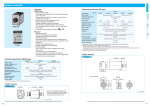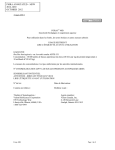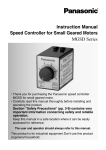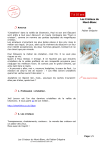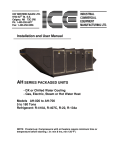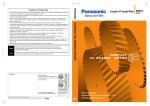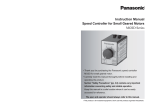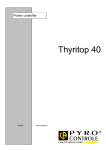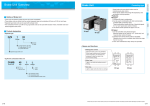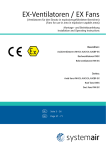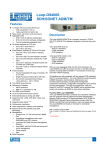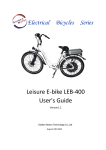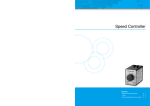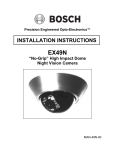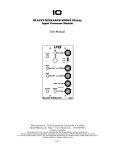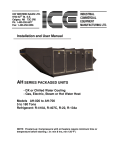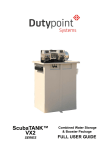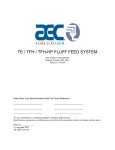Download Speed controller
Transcript
Speed controller Speed controller • Standard specification (EX type) • Features <MGSD type> EX type DV1131 DV1132 Operating voltage range 50/60 Hz Rated current Compatible motor output *1 0.4 A 1A 2.0 A 0.3 A 1A 3 to 10 W 15 to 40 W 60 to 0 W 6 to 20 W 25 to 90 W Operation change Speed control range High-response High-stability 90 to 1400 r/min / 90 to 1700 r/min 50 to 1400 r/min / 50 to 1700 r/min 5% or more 3% or less Speed variation Speed setting From external controller, e.g. external speed changer *3 Active while electric braking current is flowing. Electric braking time 5 sec typ. The braking current will be turned off before the 5-sceond limit as the motor stops. (Braking current is 2 to 3 times the rated current.) Parallel operation Enabled Available (typically up to 5 sec (0 to max. speed)) Soft-start/soft-down capability Operating temperature range –10 to 50˚C Storage temperature –20 to 60˚C *1 Applicable to Panasonic compact speed variable geared motors. Select motors with applicable output. *2 Electric braking has no mechanical brake holding mechanism. To provide brake holding, use our C&B motor or variable speed motor containing electromagnetic brake. When braking a load having excessively high inertia, durability and life expectancy of motor shaft and gear should be taken into consideration. Use the motor within the allowable inertia. *3 EX type is supplied with the external speed changer. • Outline drawing EX type 93.5(3.68) 59(2.32) 50(1.97) 14.2(0.56) 8.0(0.31) 2 8 3 1 ø29(ø1.14) 4(0.16) 3.2(0.13) 48.4(1.9) 6(0.24) 20.8(0.82) 39±0.1 (1.54±0.004) 67.1(2.64) 33(1.3) 4 36(1.42) Socket (accessory) 5 • Outline drawing MGSD type 36(1.42) 6 *1 Electric braking has no mechanical holding mechanism. 14.2(0.56) 7 MGSDA1 MGSDB1 MGSDB2 Single phase 100 to 120 VAC Single phase 200 to 240 VAC ±10% (at rated voltage) 50/60 Hz 1.0 A 2.0 A 1.0 A 3 to 40 W 60 to 90 W 6 to 90 W 50Hz : 90 to 1400 r/min 60Hz : 90 to 1700 r/min 5% : 1000 r/min, Typical variation at 80% rated torque Internal Activated while electric braking current is flowing. 0.5 sec (typ.): Amount of braking current is 2 to 3 times the rated current. Not applicable 80 g DV1234 Single phase 200 VAC ±10% (at rated voltage) Power frequency • Standard specification (MGSD type) Supply voltage Supply voltage tolerance Power frequency Rated input current Compatible motor output Speed control range Speed regulation (against load) Speed setting Braking *1 Electric braking time Parallel operation Product weight DV1231 Index • Soft-start/soft-down Time can be adjusted up to 5 seconds. Excellent soft-start/soft-down linearity. • Selectable response High-stable and high-response can be selected with the internal changeover switch to meet the characteristic of the application. (Factory setting: high-response) • Excellent instantaneous stop capability • Parallel operation Two or more motors can be controlled from a single control knob. • Can link with various control systems Can control motor(s) in conjunction with different controlling systems such as sequencer. The voltage signal can also be used as control signal. DV1134 Single phase 100 VAC Braking*2 <EX type> EX type Characteristic Rated voltage Options MGSD type Part No. Brake Unit • Internal speed changer Motor speed can be adjusted from the speed setting knob on the front panel. Not necessary to install and connect an external speed changer to the controller. • Electric brake enables instantaneous stop. • Compact 8P plug-in configuration. • Variable installation options are available. Terminal blocks, sockets and other various options (from Panasonic Electric Works Co.,Ltd.) for panel board can be used. • Compliant with international standards: 59(2.32) ø20(ø0.79) 50(1.97) t0.8(0.031) Socket is not supplied with the product. Use octal pin socket (DV0P4560), option, or Socket (AW68102) recommended by Panasonic Electric Works Co.,Ltd. Unit: mm (inch) Unit: mm (inch) * Please read your User's manual carefully so that you will understand the operation and safety precautions before attempting to operate the system. C-6 * Please read your User's manual carefully so that you will understand the operation and safety precautions before attempting to operate the system. C-7 MGSD type • Connection diagram list Page Wiring diagram (for unidirectional rotation) MGSD type C- 8 Speed change only MGSD type C- 9 Unidirectional rotation and electric brake MGSD type C-10 C-11 Wiring of cooling fan motor (F) or motor with thermal protector (TP) MGSD type C-12 Wiring to electromagnetic brake (40 W or smaller) MGSD type C-12 Wiring diagram (for unidirectional rotation) EX type C-13 Speed change only EX type C-14 Unidirectional rotation and electric brake EX type C-15 Normal/reverse rotation and electric brake EX type C-16 Multispeed setting application EX type C-17 Speed change with analog signal EX type C-17 Operation through contactless signal EX type C-18 Parallel operation through external speed changer EX type C-18 Parallel operation through analog signal EX type C-19 Soft-operation EX type C-19 Wiring of cooling fan motor (F) and motor with thermal protector (TP) EX type C-20 Wiring to electromagnetic brake EX type C-20 Panasonic Electric Works Co.,Ltd. AT7803 Speed control knob This knob adjusts the rotating speed of the motor from 90 (r/min) to 1400/1700 (r/min) at 50/60 Hz. 65 Power supply 100 VAC system: Single phase 100 to 120 VAC 200 VAC system: Single phase 200 to 240 VAC Ground the return circuit to the earth terminal. (100 Ω or smaller, ø1.6 mm or more). 43 7 8 1 2 TG Gray 7 Motor SW1 3 6 Run Stop ON OFF Black Capacitor Pink 4 TG Pink 5 Pin No. NFB 2 1 Rated voltage input Spark killer R1 C1 8 7 CW 3 CCW 6 SW1 White Gray SW2 R1 C1 Spark killer Motor SW2 Run Stop Run ON OFF ON CW Black * CCW SW1 : Power switch SW2 : Normal/reverse selector switch Capacitor Pink TG Pink Pin No. SW1 100 V supply system 5 A or more at 125 VAC SW2 200 V supply system 5 A or more at 250 VAC Spark killer R1+C1 DV0P008 (option) White Gray Black Capacitor cap Pink Pink • National specifications: Option • Specifications compliant with overseas standards: Attachment * In the case of models with a model number to which “A” is suffixed, the capacitor cap is optional. The models with a model number to which “A” is suffixed (not equipped with a capacitor cap) are not sold or available in Japan. Ground the return circuit to the earth terminal. Capacitor (100 Ω or less, ø1.6 mm or more). (supplied with the motor) Tightening torque: 1.0 to 1.5 N·m For connection to the capacitor, see the motor instruction manual. * Please read your User's manual carefully so that you will understand the operation and safety precautions before attempting to operate the system. C-8 White 5 Motor Power switch 8 4 Noise filter* Surge absorber* (option) CW SW1 • The motor revolving speed can be set from the speed setting knob on the panel. • The thick continuous lines represent main circuit. Use conductor of size 0.75 mm2 or larger for the main line. • The thin continuous lines represent signal circuit. Use conductor of size 0.3 mm2 or larger in the signal circuit. When the distance from the tachometer generator (TG) is long, use shielded twisted pair cable. Do not ground the shielding material. Miniature DIN terminal block <Precautions> The input voltage must be in the range of rated voltage compatible with the motor specification. *Install a noise filter and surge absorber to protect against external noise and lightning surge. Clockwise CCW Counterclockwise Normal/reverse rotation 1 Wiring diagram (for unidirectional rotation) Circuit breaker (NFB) : 5A <Caution> Install a ground-fault circuit interrupter in the power supply. CW Rated voltage input Index MGSD type NFB SW1 2 1 Options Normal/reverse rotation and electric brake Rotating direction viewed from shaft end Unidirectional rotation Speed controller Speed controller Brake Unit 1 2 3 4 5 6 7 8 9 10 11 12 13 14 15 16 17 18 2 Speed change only Function Speed controller Connection diagram Speed controller Speed controller <Precautions> 1. To change rotating direction of induction motor: Provide a motor halt period. Switch over SW2 after complete stop of the motor. 2. To change rotating direction of reversible motor: A motor halt period is not necessary. Switch over SW2 while keeping SW1 turned ON. When configuring SW2 with relay contacts, use a relay having large gap between contacts (e.g. HG/HP relay from Panasonic Electric Works Co.,Ltd.) to prevent malfunction due to short-circuited capacitor. 3. For motors for cooling fan and motors with thermal protector, also refer to page C-12. 4. When using independent relay contacts for SW2 to change over normal/reverse, interlock both contacts so that they will not close simultaneously. 5. The spark killer consisting of R1 and C1 must be used to protect the relay contacts. * Please read your User's manual carefully so that you will understand the operation and safety precautions before attempting to operate the system. C-9 MGSD type NFB SW1 2 1 Rated voltage input White Gray 7 8 RUN SW2 R1 STOP R2 STOP SW3 External braking resistor RUN Black Motor Capacitor Pink Pink TG Braking Run 5 Pin No. SW1 SW2 SW3 40 W or larger 7 3 6 4 5 Pin No. Rated voltage input RUN External braking resistor STOP R2 SW2 Braking Run ON RUN STOP RUN Black Motor R1 Capacitor Spark killer White STOP SW3 RUN Pink Pink TG 7 8 RUN 3 6 4 5 STOP STOP Gray Motor Black Capacitor SW3 RUN Braking Pink Run TG Pink SW1 40 W or larger SW4 SW5 CW SW1 2 1 8 CCW SW4 External braking resistor CW RUN STOP R2 CCW SW5 C1 CW SW2 R1 Spark killer 7 3 5 A or more at 125 VAC SW2 200 V supply system 5 A or more at 250 VAC Pin No. Stop Reverse STOP NFB Rated voltage input Braking ON RUN 100 V supply system DC10 V 10 mA SW4 CCW CW SW5 R2 CCW External braking resistor C1 R1 SW2 SW1 RUN CCW 0.7 sec or longer SW1 : Power switch SW2 : RUN/STOP switch SW3 : Braking start switch SW4 : Normal/reverse selector switch Gray Black Motor Capacitor White STOP Pink SW3 RUN Pink TG SW1, SW2 100 V supply system 5 A or more at 125 VAC SW4, SW5 200 V supply system 5 A or more at 250 VAC SW3 DC10 V 10m A Spark killer R1+C1 DV0P008 (option) Spark killer R1+C1 DV0P008 (option) External braking resistor R2 DV0P003 (option) External braking resistor R2 DV0P003 (option) <Precautions> 1. When SW2 and SW3 are switched from RUN to STOP, electric braking is applied for approx. 0.5 sec, and the motor stops instantly. Difference in switching time between SW2 and SW3 must be 0.1 sec or shorter. If SW2 (SW3) is in RUN position while SW3 (SW2) is in STOP, abnormal operation occurs (full speed rotation for a short time) and motor temperature rises excessively. 2. The number of start/stop operations must be 6/min. or less. 3. For motors for cooling fan and motors with thermal protector, also refer to page C-12. 4. The spark killer consisting of R1 and C1 must be used to protect the relay contacts. 5. R2 limits flow of discharging current upon short-circuiting of the capacitor during braking. * Please read your User's manual carefully so that you will understand the operation and safety precautions before attempting to operate the system. C-10 White 6 4 5 SW3 Clockwise CCW Counterclockwise CW Spark killer CW C1 CW Rated voltage input SW2 SW3 SW1 : Power switch SW2 : RUN/STOP switch SW3 : Brake start switch Gray NFB Pin No. Speed controller Speed controller 2 1 8 NFB SW1 Stop SW1 2 1 Index 3 6 4 Spark killer C1 Rotating direction viewed from shaft end 25 W or smaller Options Speed controller CW • Connection according to this wiring diagram causes the motor to rotate clockwise when viewed from the motor shaft end. To run the motor counterclockwise, interchange the connecting point of black and gray leads. Brake Unit 25 W or smaller 4 Normal/reverse rotation and electric brake Speed controller 3 Unidirectional rotation and electric brake Speed controller Speed controller <Precautions> 1. When SW2 and SW3 are switched from RUN to STOP, electric braking is applied for approx. 0.5 sec, and the motor stops instantly. (Do not operate SW4 and SW5 until the motor stops.) Difference in switching time between SW2 and SW3 must be 0.1 sec or smaller. If SW2 (SW3) is in RUN position while SW3 (SW2) is in STOP, abnormal operation occurs (full speed rotation for a short time) and motor temperature rises excessively. 2. Do not change the motor rotating direction (SW4, SW5) while the motor is running. 3. The number of start/stop operations must be 6/min. or less. 4. For motors for cooling fan and motors with thermal protector, also refer to page C-12. 5. The spark killer consisting of R1 and C1 must be used to protect the relay contacts. * Please read your User's manual carefully so that you will understand the operation and safety precautions before attempting to operate the system. C-11 MGSD type 1 Pin No. SW A Ry Closed SWB TP Blue TP Closed Closed Closed SWA SW B TP Blue Ry External speed changer (VR) Opened Closed ON ON ON • Soft-start/down control F(Black) F(Black) TP F Ry Relay TG Closed Run Reset NFB TG(Pink) Relay Ry SW A Momentary N.O. contact SW B Momentary N.C. contact 100 V supply system 125 VAC 5 A or more 3a contact 200 V supply system 250 VAC 5 A or more 3a contact <Precautions> 1. The thermal protector (TP) is an automatic reset type. To prevent hazards caused by restarting, connect the TP as shown above. Don’t connect TP directly to the power supply. 2. Once the TP operates, cooling period is required before the operation can restart. 3. Connect the cooling fan motor (F) across pins 1 and 2 on the power terminal. 4. Motor (M) and tachometer generator (TG) should be connected according to corresponding wiring diagram shown later. 6 Wiring to electromagnetic brake (40 W or smaller) Speed controller • Variable speed motor with electromagnetic brake should be wired as shown below. SW1 2 1 Pin No. NFB Rated voltage input C1 STOP RUN SW9 Motor Yellow Yellow Brake SW1 100 V supply system 5 A or more at 125 VAC SW9 200 V supply system 5 A or more at 250 VAC Spark killer R1+C1 DV0P008 (option) (supplied with the controller) Soft-start and soft-down times can be adjusted by a single setting. Use this feature to protect the load from shock caused by sharp speed change at startup and shutdown of the motor. To disable the soft operation, turn the control fully clockwise. Power supply Circuit breaker (NFB) : 5A <Caution> Install a ground-fault circuit interrupter in the power supply. 6 • Maximum speed control Use this control to adjust the revolving speed when the external speed changer is set at the top speed. Adjust the speed to 1400 (r/min) or below at 50 Hz; or 1700 (r/min) or below at 60 Hz. 5 4 3 Index Rated voltage input Ry R1 Spark killer Used to set the number of revolutions. 1/4 W, 20 kΩ, taper B Closed Options Black M White Gray 7 Wiring diagram (for unidirectional rotation) • The thick continuous lines represent main circuit. Use conductor of size 0.75 mm2 or larger for the main line. • The thin continuous lines represent signal circuit. Use conductor of size 0.3 mm2 or larger in the signal circuit. When the distance from the tachometer generator (TG) is long, use shielded twisted pair cable. Ry 2 EX type Brake Unit Speed controller 5 Wiring of cooling fan motor (F) or motor with thermal protector (TP) Speed controller Speed controller Speed controller DIN terminal block AT7803 Panasonic Electric Works Co.,Ltd. (extra-cost option) Power switch (extra-cost option) • Operation changeover switch Select “high-stable” or “highresponse”: <High-stable> • Keeps the rotation speed variation TG low against variation in load. • Enables a wide range of speed control. • Suitable for capability control. • May fail to maintain constant rotation speed upon sharp load change. <High-response> • Enables quick response with low CW hunting. • Suitable for positioning application. Motor • May fail to keep rotation speed variation low against variation in load. • Not suitable for controlling wide range of speed. 7 8 1 2 White Gray Pink Black Pink Capacitor (supplied with motor) Ground the return circuit to the earth terminal. (100 Ω or less, ø1.6 mm or more). Tightening torque: 1.0 to 1.5 N·m <Precautions> 1. Operate SW9 simultaneously with RUN/STOP switching of other switches, if any. Placing other switch to RUN position while the brake is active (SW9 at STOP position) causes the motor to generate heat. 2. For remaining wirings, refer to corresponding wiring diagram. * Please read your User's manual carefully so that you will understand the operation and safety precautions before attempting to operate the system. C-12 * Please read your User's manual carefully so that you will understand the operation and safety precautions before attempting to operate the system. C-13 EX type 8 Speed change only 9 Unidirectional rotation and electric brake Normal/reverse rotation NFB Speed controller Gray Black Motor 8 3 3 6 Capacitor 2 VR Pink VR 1 5 4 Pink TG Pink Pink TG SW2 200 V supply system ON R1+C1 Normal SW1 Reverse • With the external speed changer connected, the motor can be started/stopped with a small signal through SW6 contact while the power switch SW1 (see diagram above) is on. The SW6 provides shorter start-up time than SW1. 3 3 6 SW6 2 VR RUN 5 4 STOP 1 External speed changer (DVOP002) 1/4 W, 20 kW, taper B DC10V 10mA To TG Pin No. <Precautions> 1. Power (SW1) should be turned on at least 0.5 sec before turning on of the start signal (SW6). 2. When the motor is not operated for a prolonged time, turn off power switch (SW1). 5 A or more at 250 VAC DV0P008 (option) 5 A or more at 250 VAC SW3 3 VR RUN Pink Pink DC10 V 10 mA R1+C1 DV0P008 (option) R2 DV0P003 (option) TG 1 40 W or larger CW SW1 NFB Operation from maximum speed control • When no external speed changer is required, the speed can be adjusted from the maximum speed control. 3 6 R3 20 kΩ 1/4 W To TG Pin No. <Precautions> 1. Connect a fixed resistor (R3) in place of external speed changer (VR). Braking Rated voltage input CCW SW1 : Power switch SW2 : Normal/reverse selector switch 5 4 SW2 200 V supply system 2 SW3 2 1 * Please read your User's manual carefully so that you will understand the operation and safety precautions before attempting to operate the system. C-14 STOP RUN 5 A or more at 125 VAC SW2 5 A or more at 125 VAC STOP RUN <Precautions> 1. To change rotating direction of induction motor: Provide a motor halt period. Switch over SW2 after complete stop of the motor. 2. To change rotating direction of reversible motor: A motor halt period is not necessary. Switch over SW2 while keeping SW1 turned ON. When configuring SW2 with relay contacts, use a relay having large gap between contacts (e.g. HG/HP relay from Panasonic Electric Works Co.,Ltd.) to prevent malfunction due to short-circuited capacitor. 3. For motors for cooling fan and motors with thermal protector, also refer to page C-20. 4. When using independent relay contacts for SW2 to change over normal/reverse, interlock both contacts so that they will not close simultaneously. 5. The spark killer consisting of R1 and C1 must be used to protect the relay contacts. Start/stop control with small signal R2 3 SW1 100 V supply system Capacitor Pin No. CW Black 8 Stop Run Gray Speed controller Stop Run Motor R1 SW2 5 4 This wiring diagram causes the motor to rotate clockwise when viewed from the motor shaft end. To run the motor counterclockwise, interchange the connecting point of black and gray leads. SW1 100 V supply system 8 Black C1 STOP RUN 6 Pin No. Pin No. SW1 Motor Gray 7 Index 1 5 4 Black Capacitor 3 CW White Gray SW2 CCW R1 C1 2 Rated voltage input White CW 7 8 3 6 C1 • Connection according to this wiring diagram causes the motor to rotate clockwise when viewed from the motor shaft end. To run the motor counterclockwise, interchange the connecting point of black and gray leads. NFB Options Speed controller White 7 Rated voltage input R1 CW SW1 2 1 NFB SW1 2 1 Rated voltage input Speed controller SW1 2 1 25 W or smaller Brake Unit Unidirectional rotation Speed controller Speed controller SW1 RUN STOP R1 Capacitor C1 6 5 4 STOP SW3 3 VR Pink Pink RUN RUN SW1 : Power switch SW2 : RUN/STOP switch SW3 : Brake start switch 2 RUN STOP SW2 SW3 White 7 3 Motor Run ON R2 SW2 Braking TG 1 Pin No. <Precautions> 1. When SW2 and SW3 are switched from RUN to STOP, electric braking is applied for approx. 5 sec, or until the motor stops. SW2 and SW3 must be operated simultaneously. Otherwise, abnormal operation occurs (full speed rotation for a short time), causing the motor temperature rises excessively. 2. The number of start/stop cycles must be 6/min. or less. 3. When using cooling fan motor or motor with thermal protector, also see page C-20. 4. Insert R1 and C1 to protect relay contact. 5. R2 restricts discharge current in case of capacitor short circuit during braking. Operation from maximum speed control • When no external speed changer is required, the speed can be adjusted from the maximum speed control. 3 6 STOP SW3 RUN R3 20 kΩ 1/4 W 5 4 To TG Pin No. <Precautions> 1. Connect a fixed resistor (R3) in place of external speed changer (VR). * Please read your User's manual carefully so that you will understand the operation and safety precautions before attempting to operate the system. C-15 EX type 10 Normal/reverse rotation and electric brake 11 Multispeed setting application No braking applied STOP SW3 Rated voltage input Rotating direction viewed from shaft end CW SW4 White CCW STOP RUN CCW Counterclockwise Gray R1 SW2 Motor Black CW SW5 R2 STOP 6 SW4, SW5 200 V supply system 5 A or more at 250 VAC Capacitor 3 SW3 SW1, SW2 100 V supply system 5 A or more at 125 VAC SW3 2 VR RUN Pink TG Pink 1 5 4 DC10 V 10 mA R1+C1 DV0P008 (option) R2 DV0P003 (option) Gray SW4 VR2 1 VR3 1 2 Pin No. 1 VR2 SW3, SW8 3 2 VR1 2 VR3 1 DC10V 10 mA VR1 DV0P002 VR2 1 (option) VR3 5 4 To TG To TG Pin No. R2 8 Black CCW CW SW2 RUN R1 STOP C1 SW5 Capacitor CCW Motor Stop Reverse Normal SW1 ON SW2 SW3 STOP SW4 SW5 RUN RUN CW CCW White 7 STOP 3 SW3 VR RUN No braking applied Braking SW1 Pink Pink TG SW1 : Power switch SW2 : RUN/STOP switch SW3 : Braking start switch SW4,SW5 : Normal/reverse selector switch 1 Pin No. <Precautions> 1. When SW2 and SW3 are switched from RUN to STOP, electric braking is applied for approx. 5 sec, or until the motor stops. (Do not operate SW4 and SW5 until the motor stops completely.) SW2 and SW3 must be operated simultaneously. Otherwise, abnormal operation occurs (full speed rotation for a short time), causing the motor temperature rises excessively. 2. Do not change the rotating direction (SW4, SW5) while the motor is running. 3. The number of start/stop cycles must be 6/min. or less. 4. When using cooling fan motor or motor with thermal protector, also see page C-20. 5. Insert R1 and C1 to protect relay contact. 6. R2 restricts discharge current in case of capacitor short circuit during braking. Operation from maximum speed control • When no external speed changer is required, the speed can be adjusted from the maximum speed control. Speed controller Speed controller 1 5 4 NFB Rated voltage input CW 3 6 STOP Rated voltage input MAX DC5V 6 GND 5 4 To TG Pin No. Braking applied SW1 2 1 3 NFB Rated voltage input STOP SW7 6 MAX DC5V GND RUN 5 4 To TG 6 5 4 5 A or more at 125 VAC 200 V supply system 5 A or more at 250 VAC To TG Pin No. <Precautions> 1. Connect a fixed resistor (R3) in place of external speed changer (VR). DC10 V 10 mA GND R1 1 kΩ emax (r/min) 1700 1400 R2 1000 To TG 0 emax 3 – 1 kΩ emax : Analog signal max. voltage 500 Pin No. 100 V supply system SW7 5 R2 3 Pin No. SW1 RUN R3 20 kΩ 1/4 W 4 NFB 2 1 3 <Precautions> 1. Turn on power switch SW1 approx. 0.5 sec earlier than the analog start signal. 2. For repetitive run/stop operations, use the analog signal while keeping SW1 ON. 3. Soft-operation can be adjusted from the soft-start and softdown controls or by using analog signal. 4. On the maximum speed control, set the maximum motor revolving speed that may be achieved at the maximum analog signal value (e.g. 3 VDC). 5. The absolute maximum rating of analog signal is 5 VDC. The system should be designed to use standard 3 VDC analog signal. If the signal voltage exceeds 3 VDC, the circuit diagram shown below should be used for wiring. SW3 * Please read your User's manual carefully so that you will understand the operation and safety precautions before attempting to operate the system. C-16 2 2 VR1 3 3 <Precautions> 1. Set external speed changers VR1, VR2 and VR3 to 3 different speeds and select the desired speed from SW8. 2. When activating the brake, simultaneously switch over SW3 and RUN-STOP of other switches. 3. For remaining wirings, refer to the corresponding wiring diagrams. Speed controller SW1 2 1 5 4 2 Speed controller Braking 40 W or larger 6 3 3 3 SW8 RUN 6 12 Speed change with analog signal Pin No. 3 SW8 6 Index 3 CCW Speed controller 8 C1 Clockwise 3 Options Speed controller CW Speed controller 3 Speed controller 2 1 7 Braking applied NFB SW1 Brake Unit 25 W or smaller Speed controller Speed controller 1 2 3 (V) R1 : External resistor: 1 kΩ R2 : External resistor Analog signal (DC) 6. Revolution speed “0” signal should not exceed 0.1 VDC. 7. The input speed pattern (curve) may not be exactly reflected on the motor speed, due to inertial effect of the load, especially during stop sequence. 8. The percentage ripple of analog voltage signal should be 2% or less. 9. For other wirings, refer to the corresponding circuit/wiring diagrams. 10. When using the braking feature, motor wiring (pins 1, 7 and 8) should be in accordance with pages C-8 and C-9. To activate braking, switch SW2 and SW7 at the same time. If SW2 is in RUN position while SW7 is in STOP, abnormal operation occurs (full speed rotation for a short time); or if SW7 is in RUN position while SW2 is in STOP, motor temperature rises excessively. * Please read your User's manual carefully so that you will understand the operation and safety precautions before attempting to operate the system. C-17 EX type 15 Parallel operation through analog signal Braking applied Tr STOP 1 RUN 5 4 Pin No. To TG Internal equivalent circuit 3 6 VR 1 Tr RUN STOP 5 4 To TG Pin No. 3 6 MAX DC5V 3 1 kΩ 6.2 V 1 μF RUN Tr STOP 22 kΩ GND 5 4 6 To TG 1 μF 5 Speed controller Speed controller 1 3 6 5 4 Pin No. 3 6 5 4 Pin No. To TG Pin No. To TG Index 2 VR 5 4 16 Soft-operation To TG <Precautions> 1. Power switch SW1 should be turned on approx. 0.5 sec before the operation start signal from SW6. 2. When repeating run/stop cycles, turn on/off only SW6 while keeping SW1 turned ON. In this way, the motor can be controlled by using a small signal. To stop operation for a long time, also turn off SW1. 3. Soft-start/soft-down period is the time required for the equipment to start up from stop state to full speed when the external speed changer is set at maximum value. 4. Soft-start/soft-down control, when at the full clockwise position, disables the soft-down function. As the stop signal is input, power supply to the motor is turned off immediately. However, the revolving speed gradually decreases in proportion to the inertia of the load and motor starts free-running stop sequence. 5. Soft-start/soft-down control can set maximum time length of approx. 5 seconds (Typ. at FCCW). The setting may be exceeded if the inertia of the load is too large. 6. For other electrical connections, refer to corresponding circuit/wiring diagrams. Electrical wirings are the same as for “Unidirectional rotation and electric brake” and “Normal/reverse rotation and electric brake”. Adjust the soft-start time from the soft-start/down control. * Please read your User's manual carefully so that you will understand the operation and safety precautions before attempting to operate the system. NFB SW1 • Soft-start, soft-down 3 3 6 To TG • Soft-start and electric brake C-18 5 4 Pin No. 14 Parallel operation through external speed changer <Precautions> 1. The resistance Rs of the external speed changer VR should be as follows: Rs = 20/N (kΩ) where, N is the number of motors. 2. For synchronous operation or ratio operation, desired revolving speeds must be set from the maximum speed control. Soft-start and soft-down controls and operation changeover switch must be set to the same position. 3. Wirings from the external speed changer VR should be connected to the same pins (No.5 and 6) on the controller. 4. Malfunction may occur as the number of devices operated in parallel increases. To secure correct operation, connect a noise filter to each unit. 5. For other electrical connections, refer to corresponding circuit/wiring diagrams. 3 6 Pin No. 1 kΩ 2 1 Speed controller VR 2 Speed controller 2 Speed controller 3 6 Analog signal and brake 3 Options Speed controller 3 DC 0 to +3 V GND Brake Unit No braking applied <Precautions> The input impedance of the controller is approx. 100 kΩ. The output impedance of the analog signal source should be determined based on the total input impedance of the speed controllers. Speed controller • Small signal relays SW3, SW6 and SW7 can be replaced with transistor. Speed controller 13 Operation through contactless signal Speed controller Speed controller Rated voltage input To motor 3 6 2 RUN 3 VR DOWN 1 SW6 5 4 To TG Pin No. SW1 100 V supply system 5 A or more at 125 VAC 200 V supply system 5 A or more at 250 VAC SW6 DC10 V 10 mA Soft-start Soft-down Speed SW1 SW6 ON RUN 0.5 sec or more * Please read your User's manual carefully so that you will understand the operation and safety precautions before attempting to operate the system. C-19 EX type Speed controller 48 mm sq. (1.89 inchsq.) type • Features Ry Closed 1 Closed Closed Closed SW A SW A Ry 2 Pin No. Black M White Gray F(Black) F(Black) TP Blue TP SW B Opened Closed Ry ON Closed ON ON Reset SW B TP TP Blue Closed Run NFB Ry Rated voltage input F SD48 type TG TG(Pink) Options • First DIN 48 size in the industry Compact space saving model (control panel) (standardized panel machining holes) A wide choice of options (recommended by Panasonic Electric Works Co.,Ltd.) • Simplified and neat wiring arrangement Main circuit and signal inputs are isolated on the terminal block. Use of 8-pin terminal block requires fewer wiring connections. • Can operate under a wide range of power supply voltage (100V 100 to 120V, 200V 200 to 240V) Brake Unit Speed controller 17 Wiring of cooling fan motor and motor with thermal protector Speed controller Speed controller EX48 type Index Ry SW A Momentary N.O. contact SW B Momentary N.C. contact 100 V supply system 125 VAC 5 A or more 3a contact 200 V supply system 250 VAC 5 A or more 3a contact Ry <Precautions> 1. The thermal protector (TP) is an automatic reset type. To prevent hazards caused by restarting, connect the TP as shown above. Don't connect TP directly to the power supply. 2. Once the TP operates, cooling period is required before the operation can restart. 3. Connect the cooling fan motor (F) across pins 1 and 2 on the power terminal. 4. Motor (M) and tachometer generator (TG) should be connected according to corresponding wiring diagram shown later. • Standard specification SD48 type Part No. 18 Wiring to electromagnetic brake DVSD 48AL DVSD 48BL DVSD 48CL EX48 type DVSD 48AY DVSD 48BY DVSD 48CY DVEX 48AL DVEX 48BL DVEX 48CL DVEX 48AY DVEX 48BY DVEX 48CY Characteristic Speed controller • Variable speed motor with electromagnetic brake should be wired as shown below. SW1 Rated voltage NFB 2 1 Rated voltage input Pin No. R1 SW9 RUN STOP Yellow Yellow Motor Brake SW1 100 V supply system 5 A or more at 125 VAC SW9 200 V supply system 5 A or more at 250 VAC R1+C1 200 to 240 VAC 200 to 240 VAC ±10% (at rated voltage) Power frequency 50/60Hz 50/60 Hz Compatible motor output *1 Speed variation 0.5 A 1.0 A 2.0 A 0.3 A 0.5 A 1.0 A Speed setting Brake *3 Parallel operation Soft-start/down 0.5 A 1.0 A 2.0 A 0.3 A 0.5 A 1.0 A 3 to 20 W 25 to 40 W 60 to 90 W 3 to 20 W 25 to 40 W 60 to 90 W 3 to 20 W 25 to 40 W 60 to 90 W 3 to 20 W 25 to 40 W 60 to 90 W 90 to 1400 r/min / 90 to 1700 r/min DV0P008 (option) <Precautions> 1. SW9 should be switched to RUN or STOP at the same time as the other switches are switched to RUN or STOP. If the other switches are set to RUN while the brake is energized (SW9 in STOP position), the motor will generate heat. 2. For other wirings, refer to the corresponding circuit/wiring diagrams. If the application is speed change without using electric braking (page C-14), perform wiring according to “Start/stop control with small signal”. 100 to 120 VAC ±10% (at rated voltage) Rated current C1 100 to 120 VAC Operating voltage range Internal Mode A (high-response mode) : 50 to 1400 r/min / 50 to 1700 r/min Mode B (high-response mode) : 90 to 1400 r/min / 90 to 1700 r/min *2 External speed changer, analog voltage, maximum speed setting control Applies braking force to the motor by feeding electric braking current to the motor for 0.5 sec (typ) Applies braking force to the motor by feeding electric braking current to the motor for 5 sec (typ) (Turns off electric braking current even within 5 sec as the motor stops.) Not possible Possible Not applicable Variable up to 5 sec (typ) (0 to max. revolving speed) Operating temperature range –10 to 50˚C –10 to 50˚C Storage temperature –20 to 60˚C –20 to 60˚C *1. Applicable to Panasonic compact geared motors and variable speed motors. *2. EX48 models are set to mode A (high-stable) upon shipment. *3. Electric braking has no mechanical brake holding force. To provide the holding force, use a variable speed motor with electromagnetic braking feature. * Please read your User's manual carefully so that you will understand the operation and safety precautions before attempting to operate the system. C-20 * Please read your User's manual carefully so that you will understand the operation and safety precautions before attempting to operate the system. C-21








